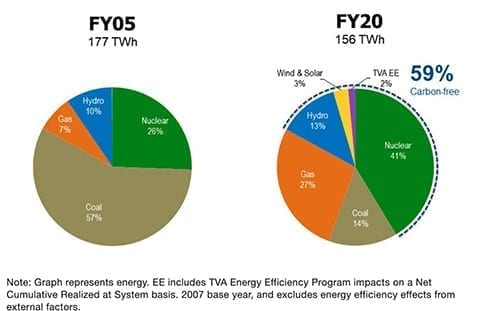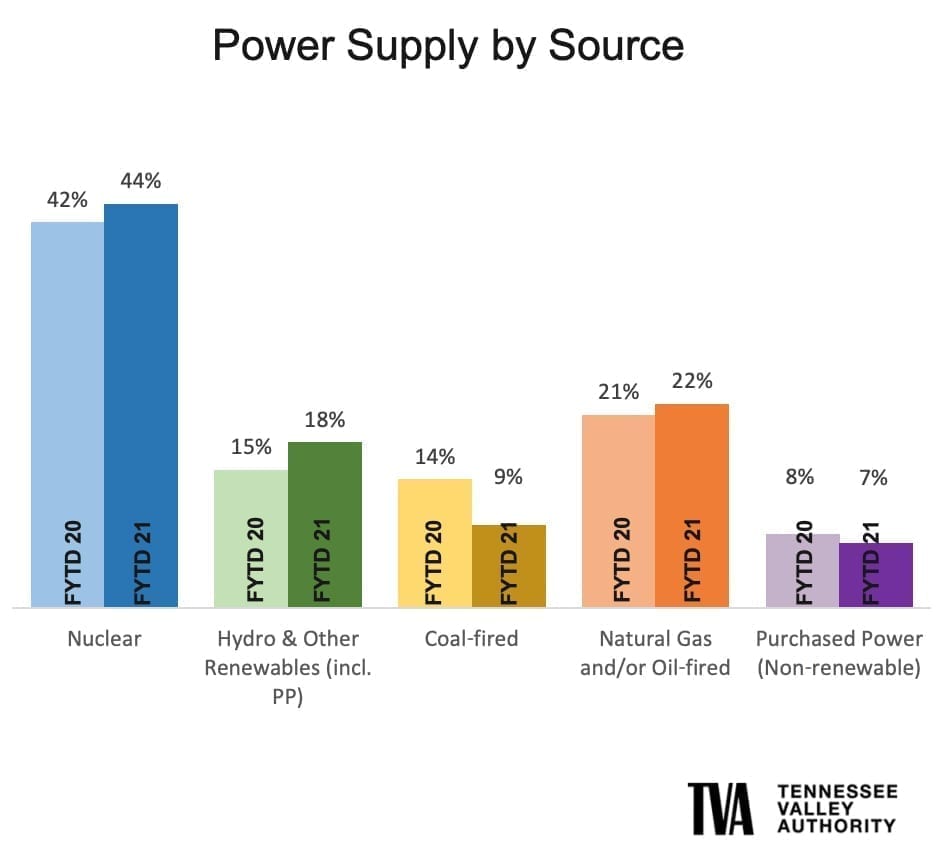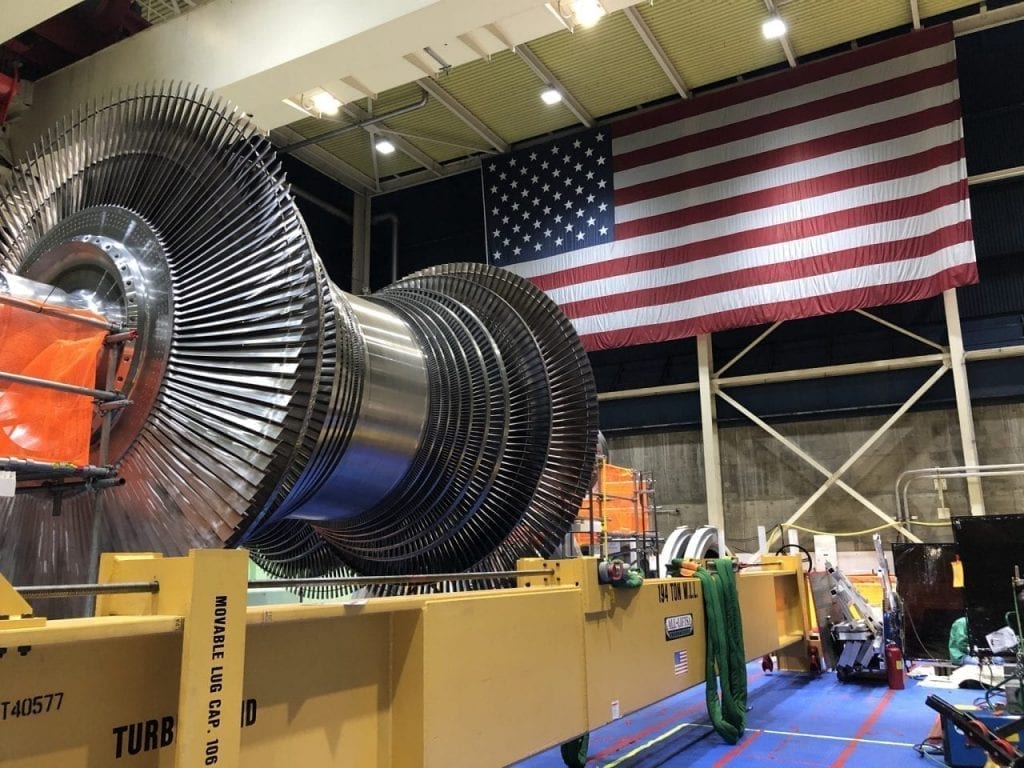TVA, Eyeing Coal Phaseout by 2035, Will Rely on Nuclear
The Tennessee Valley Authority (TVA) expects to phase out its coal generation by 2035, but achieving net-zero carbon emissions without raising power prices or adversely affecting reliability will require substantial investments in energy storage and carbon capture and sequestration (CCS). TVA also will need to extend the lifetime of its nuclear power, and adopt the use of small modular reactors (SMRs), said Jeffrey Lyash, its president and CEO.
During a fireside chat with Sen. Joe Manchin (D-W.Va) on April 28 hosted by the nonprofit international think tank the Atlantic Council—an event focused on the future of low carbon generation in the Appalachian region—Lyash noted the self-funded U.S. corporate agency has already retired 60% of its coal generation. “Our coal units will continue to retire over the next 15 years because they’ve reached the end of life,” he said.
However, TVA’s 2035 coal phaseout is still an “aspirational target” that will depend on environmental impact studies, and ultimately, a board-approved recommendation by the company, spokesperson Jim Hopson told POWER. While TVA does not intend to invest in its coal plants to extend their lifetimes and it “knows the path that it generally wants to take,” environmental impact statements “sometimes can take years to fully prepare and to complete all the necessary studies, so it is unlikely that the board will receive a recommendation for all the plants simultaneously.” he explained. “It’s possible, but more than likely, coal will be phased [out] over a period of a few years.”
The declaration is still a noteworthy development for TVA, which federal legislation created in 1933. As the nation’s largest public power supplier today, the entity has a footprint that serves 10 million people, including in most of Tennessee, northern Alabama, northeastern Mississippi, and southwestern Kentucky and portions of northern Georgia, western North Carolina, and southwestern Virginia.
TVA’s effort is also in line with those by several major coal power generating utilities in recent years, which are targeting net-zero carbon emissions by 2050. The federal government, too, is pushing for decarbonization, and though it faces pushback in Congress, the Biden administration has proposed a100% carbon-free power target for the U.S. by 2035.
Coal Carried TVA for Decades
Last week, Lyash highlighted the TVA’s original mission to spur economic development in the Tennessee Valley and Appalachia, but he noted the entity is also committed to environmental stewardship. Both aspects have driven a significant change in its power generating portfolio (Figure 1), he said.

While TVA began its coal-fired construction program in the 1940s, the majority of its coal units were placed in service between 1951 and 1973. Just 10 years ago, TVA produced 74,583 GWh—or about 52% of its total generation—from 53 active units at 11 coal plants. Increasingly stringent regulatory requirements over the past decade, along with environmental agreements with several states and environmental groups, forced the company to retire 18 coal units by 2017.
As of September 2020, TVA had just five coal-fired plants consisting of 25 active units. Its most recent retirement is Paradise Unit 3, a 1,080-MW unit. Future retirements slated for now only include the 865-MW, 1967-built Bull Run Fossil Plant by December 2023.
When Bull Run closes, its still-operating coal fleet will include the 2.5-GW, two-unit Cumberland station in Tennessee; four units at the 976-MW Gallatin plant in Tennessee; the 1.4-GW, nine-unit Kingston plant, also in Tennessee; and the 1.2-GW, nine-unit Shawnee plant in Kentucky. However, as Lyash noted on Wednesday, all four plants will have reached the end of their lifetime by 2035. Gallatin, Kingston, and Shawnee were built in the mid-to-late-1950s, while Cumberland was placed in service in 1973.
The TVA’s transition efforts have so far been economically fruitful, Lyash said. “In the last five years, we’ve attracted about $47 billion in capital and helped to attract or retain about 340,000 jobs,” he said. “There are places for the existing workforce to transition to. For example, we helped recruit the General Motors electric vehicle platform here.”
Focused on creating jobs associated with “these future energy infrastructure issues,” TVA has also built several new high-efficiency gas generation units on the site of its Allen and Paradise coal units “to preserve that tax base and at least a significant part of those jobs,” he said. At its Widows Creek coal unit, meanwhile, TVA helped attract a Google data center, “which is actually a significant net increase in jobs, and we built solar facilities.”
Lyash: TVA Will Need Nuclear Lifetime Extensions, SMRs
While TVA’s “low-carbon” plans include renewables—“solar and wind as much as that system can integrate, there are limitations to that,” Lyash noted. TVA’s “first priority” today is “to preserve and extend the valuable nuclear fleet we have running in this country by addressing the dysfunctions in the organized markets and in the revenue models that we’ve set up that inappropriately disadvantage these very valuable plants,” he said.
However, further shifts in its portfolio, including through new technology, will be necessary to achieve more dramatic greenhouse gas (GHG) reductions, he said. “We have reduced our GHGs by 63% over the 2005 benchmark as of 2020. We’re executing a plan to get to 70% by 2030, and 80% by 2035 with existing technology, and without raising prices or adversely impacting reliability, so we’re driving as hard as we can,” he said.

“But we cannot even attain those numbers unless we preserve and extend the life of our existing nuclear fleet, and of those technologies that we need to establish to close that gap between 80% and 100% reduction, they are energy storage, carbon capture that we can apply to our fossil fuels—including gas—and new nuclear in the form of SMRs,” said Lyash.
Currently, TVA operates three nuclear plants: the three-unit 3.3-GW Browns Ferry plant in Alabama; the two-unit 2.3-GW Sequoyah plant in Tennessee; and the two-unit 2.3-GW Watts Bar plant in Tennessee. All its units were placed in service between 1974 and 1982, except Watts Bar’s, which came online in 1996 and 2016. Watts Bar Unit 2 was POWER’s 2018 Plant of the Year. Sequoyah 1 is licensed through 2040, and Unit 2, through 2041. Watts Bar 1 is licensed through 2035.
Browns Ferry, its oldest nuclear plant, already has renewed 20-year NRC licenses that will allow the units to operate from 2033 to 2036. In 2019, TVA also wrapped up a $475 million extended power uprate at Browns Ferry to boost the plant’s output by 465 MW. Browns Ferry 2, notably, completed a significant upgrade just last week during a scheduled maintenance and refueling outage, allowing it to generate an additional 7 MW of power.
The upgrade entailed large-scale replacements of major components on all three of Unit 2’s low-pressure turbines, including new rotors (Figure 3), inner casings, steam piping and bellows, and turbine supervisory instruments. Also notable is that the refueling team loaded four first-of-their-kind 3-D printed fuel assembly brackets in the Unit 2 reactor.

While the upgrades have been pivotal in boosting TVA’s nuclear’s share to 44% of its total generation output, TVA spokesman Hopson also noted that TVA has been running them longer. “We’ve just had a great deal of operational success with our nuclear units. They are our largest source of carbon-free power, and they are a leading source of baseload 24-7 power,” he said.
Looking ahead, SMRs look increasingly promising, Lyash suggested. “I would tell you there are technologies ready to build now, light water SMRs. There are Gen IV SMRs like the liquid sodium and molten chloride salt high-temperature gas-cooled reactors that are being developed.” Still, rolling out those first-of-a-kind will require government support, he said: “First-of-a-kind risks and costs are substantial, but the investment in that will generate the solution to the low-carbon future and create an export [base] for the U.S.”
TVA, Lyash noted, already has an early site permit (ESP), issued by the Nuclear Regulatory Commission (NRC) in December 2019, for its Clinch River site near Oak Ridge, Tennessee. The site has the “only ESP for an SMR,” Lyash said. “TVA is ready to lead in this area if the nation needs it to lead,” he said.
While TVA’s 2016 ESP application to the NRC detailed two or more SMR modules of up to 800 MW on the 935-acre Oak Ridge site (which previously hosted the former Clinch River Breeder Reactor Project), the company has not made a firm decision to pursue deploying a reactor at the site.
However, TVA is continuing to gather additional information to inform any future decisions, said Hopson. “We continue to explore the possibilities of the various designs that are out there for light water SMR designs,” he said. “Ultimately, we will have to make a decision based upon what we believe is the best interest of those we serve. But we want to have that option open to us, which is why we believe that continued development and interest in SMRs is something TVA is definitely going to continue to be involved in as we move forward,” he said.
Sen. Manchin Urges ‘Reality-Based’ Action on Climate
Manchin, a centrist Democrat who serves as chair of the Senate Energy and Natural Resources Committee, during the fireside chat last week also expressed skepticism about U.S. efforts to move past coal without stronger efforts to build out supportive infrastructure holistically. “I’m more concerned about the way we’re depending on transforming this energy portfolio because we do very little manufacturing of solar panels, we do very little manufacturing of windmills, and we’re dependent on foreign supply chains,” he said.
As a representative of the state of West Virginia—whose economy thrived on coal production and coal power—Manchin lauded Biden’s plans to invest in communities “who really believe they have been left behind, and I’m very pleased the president understands no community, and especially those who have contributed so much to our country.” Manchin added: “The freedoms we’ve been able to endure and preserve and persevere with have been because of the hard work that coal miners have done over the years providing the energy that we’ve needed and basically made us the country that we are, the superpower of the world.”
Manchin suggested the current trajectory to achieve ambitions for a net-zero economy—“that means everything we do, which is our transportation, our factories, our homes, everything”—is skewed if coal’s contributions aren’t taken into account. “We have five nuclear reactors that are going offline this year—5.1 GW going offline,” the senator noted. At the same time, “there are about 1,063 coal-fired plants being built around the world today—not one in America. When these new plants are completed, that’ll be 76,166 coal-fired plants in the world, while we’re still at 504,” he said.
“What we’re dealing with makes no sense. They’re not dealing with reality” if global climate change mitigation is a priority, Manchin said. “CCS is the way we must go if you want to really help global climate.” Efforts must also ramp up to build a domestic supply chain of rare earth minerals, he said.
“I want people to meet reality head-on in the real world.”
—Sonal Patel is a POWER senior associate editor (@sonalcpatel, @POWERmagazine).